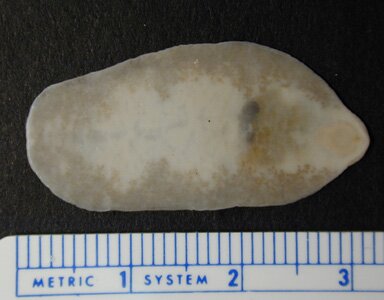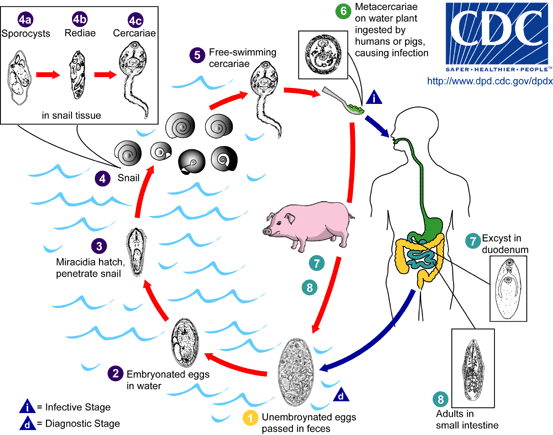Fasciolopsasis (Fasciolopsis buski)

 Fasciolopsasis (Fasciolopsis buski). The parasite is widespread in the Far East and on the Indian subcontinent. It occurs in regions where people breed pigs and eat raw water plants (water nuts and water chestnut).
Fasciolopsasis (Fasciolopsis buski). The parasite is widespread in the Far East and on the Indian subcontinent. It occurs in regions where people breed pigs and eat raw water plants (water nuts and water chestnut).
Fascilopsasis infection symptoms:
- most infections have a mild character without clinical symptoms.
Intensive fascilopsasis infestation leads to:
- small bowel mucosa ulceration
- assimilation disorders
- diarrhoeas
- toxemia
- alergic reactions
Fasciolopsasis can lead to death in cachexy and hipoproteinemy, proceeding with advanced and overall swellings and abdominal dropsy
Fasciolopsasis development cycle
The first hosts of this parasite are water snails Segmentina nitidella, Segmentina hemisphaerula, Hippeutis schmackerie, Gyraulus, Lymnaea, Pila, Planorbis (Indoplanorbis) and Zebrina. They become infected when flukes get into their organisms. In a snail organism, the flukes go through several development phases (sporociste, redia, cercaria) then abandon it and embed in water plants, often in water nuts-Trapa Natans and water chestnuts Eliorachis Tuberose. Then they transform into metacercaria, which are randomly eaten by pigs or men. There is a chance that you get infected by drinking water containing metacarceria, as it can be found on its surface. In an alimentary system a larva sticks to the walls of the bowel or the duodenum and grows. The life-span of a mature individual is about a year. Fluke eggs are excreted and get into a water reservoir and the parasite cycle closes.

Incoming search terms:
- Trichinella spiralis
- fasciolopsis buski
- pneumocystis jiroveci life cycle
- phthirus pubis
- pneumocystis life cycle
- Pneumocystis jirovecii
- cycle of parasites
- pneumocystis carinii life cycle cdc
- phthirus pubis life cycle
- fascelopsis





